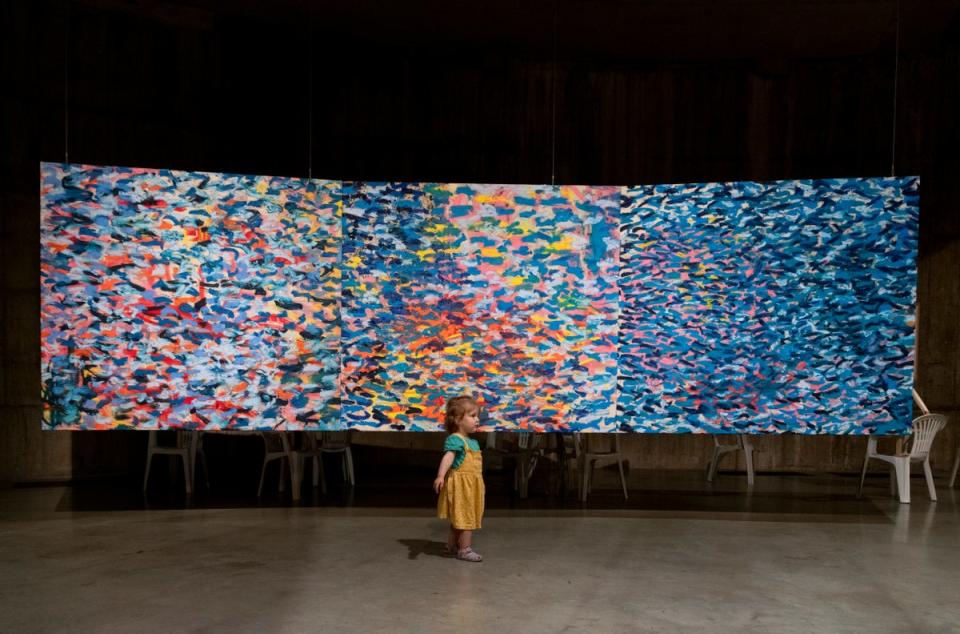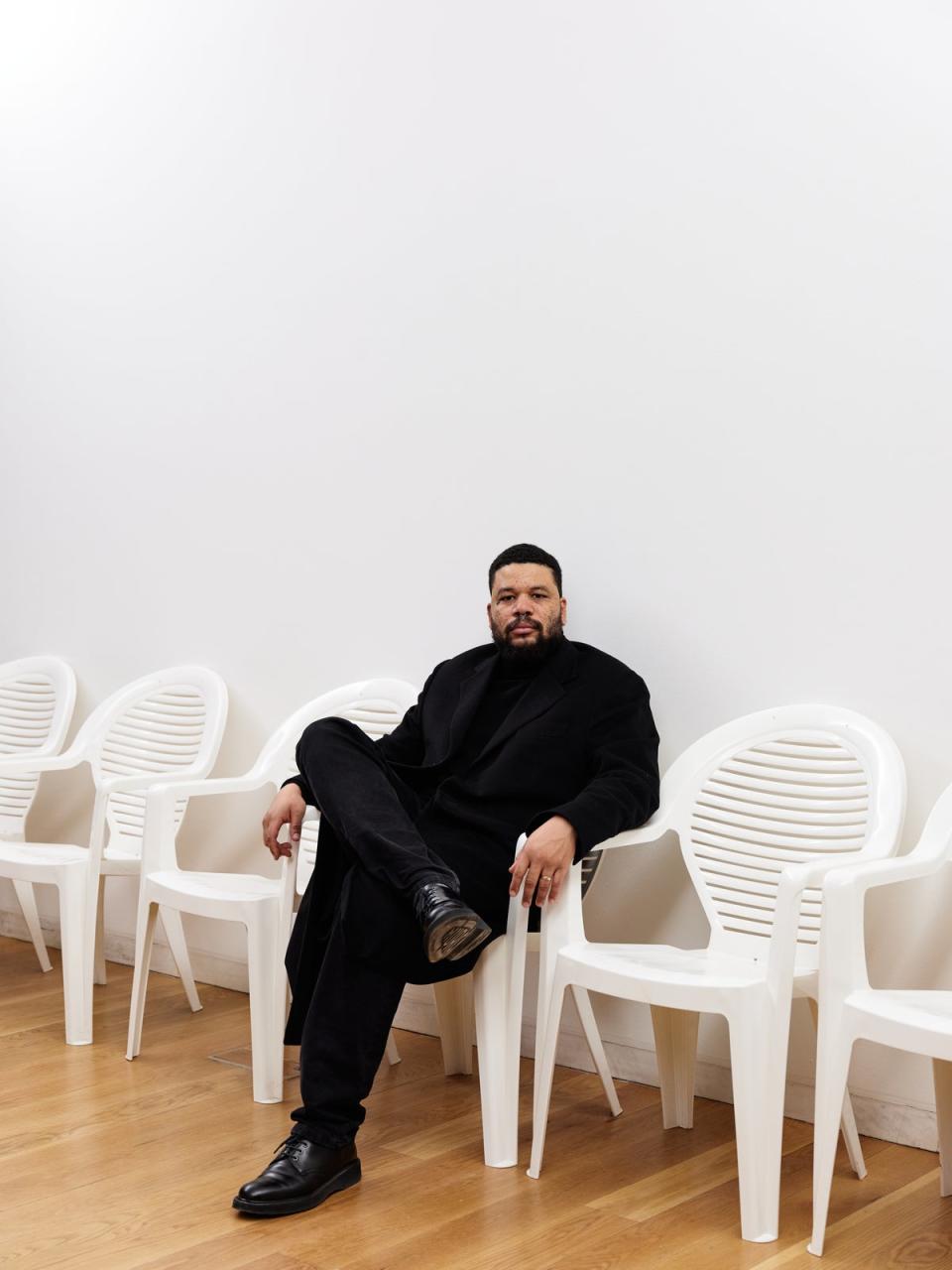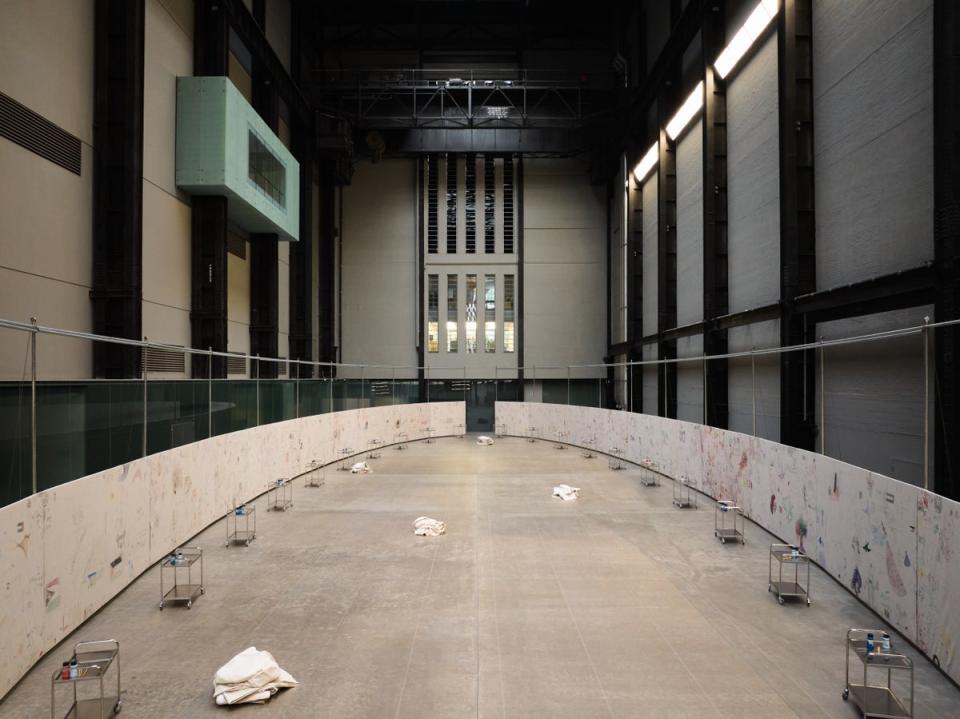For all the budding artists out there who’ve always dreamed of exhibiting a painting at Tate Modern… now’s your chance, all thanks to Turner Prize winner Oscar Murillo.
His new project, called The Flooded Garden (the title is in lowercase), takes over the gallery’s iconic Turbine Hall and it’s a work that allows Londoners (and others) to express their artistic side.
The flooded garden consists of enormous canvases mounted on scaffolding, inviting visitors of all ages to pick up a paintbrush and make their mark. “It’s about unfettered freedom and unfettered connection with just letting go,” the artist says.
It opened this weekend and people are already flocking in, prompting one critic to call the work irresistible. “Paint is energy, it is life,” they enthused.
Murillo is known for his inventive works that range from paintings to sculptures, installations to live events. He frequently explores issues of the collective, social bonds and cultural exchanges.
We meet on the fifth-floor terrace of Tate Modern, enjoying the first sunny day in what feels like an eternity. It happens to be the opening of Parliament, and helicopters circle overhead as we chat.
Murillo is as cool as can be, dressed all in black, with multiple earrings, a short beard and a black cap with ‘Forgotten Fantasy’ written on it in yellow. He is relaxed and great company, always willing to question any question from different angles – an hour flies by.

I wonder what it means for an artist to have work in the Turbine Hall, after so many iconic pieces: from Carsten Holler’s helter skelter slides to Olafur Eliasson’s The Weather Project. “It’s a huge honour,” he says. “And when I was growing up in London, the Tate was the home institution. It’s the pinnacle, it doesn’t get any better than that as an artist, it’s a huge accolade.”
He continues: “It’s a response to Turbine Hall, it’s a response to London as a city with its generous green spaces. London stands out from other cities around the world because of its beautiful green spaces – parks and gardens.”
The main inspiration for this work was Claude Monet and his garden in Giverny. This garden was the inspiration for his paintings Water Lilies and many other impressionists.
“My eureka moment was when I realized he had cataracts when he was working on the paintings,” Murillo says. “So as cute as the paintings were, he was in a moment of torment and hostility toward himself. I used that as a jumping-off point for my own issues as an artist.”
He created an idea of a man isolated in a beautiful space and suffering. “From that antagonistic state he made radical work that is now loved and celebrated by the world.”
And in this project, while it’s ostensibly fun and participatory – it goes by the name Uniqlo Tate Play, and he wants people to have a good time – he points to the dark side of individuals painting over other people’s work. “There’s this flood. They’re going to wipe out what’s already there. There’s this kind of violence, which I call ‘social cataracts’, there’s this collective wipeout where you come across something and you ignore it.
“We’ve been like this since the 1980s; we’ve been forced by the systematic reordering of civilizations not to care about each other as much. We’ve been funneled through a system that revolves around the individual.”


The Flooded Garden is not the first time Murillo has worked with the public. He did it for ten years with schoolchildren from around the world in a project called Frequencies, stapling canvases to desks and watching what they drew on them.
“I did it first in Colombia and it motivated me to keep going – it went on for 10 years. It’s beautiful to see kids doing something without doctrine. You start to see the indoctrination of society in how kids change as they get older. It shows you how we condition ourselves. How we calcify and become more rigid.”
Murillo moved with his family from La Paila, a small village in western Colombia, to London in 1996 when he was 10. His father was a trade unionist and had been forced to flee the country. “There was a significant number of us who came to London.”
The move was hard, but he found solace in art. “London is such a rich city, but when even the language is not your own, you are so displaced that you feel like you are in a barren place. Drawing started to give me solace and reconciliation.”
He adds: “Drawing and painting were things I loved and used as therapy. I was completely removed from my own cultural soil, which is what connects us to a place, friends and culture in general. That was eradicated.”
After throwing himself into art and leaving school, he gained a Bachelor of Fine Arts from the University of Westminster and then a Masters from the Royal College of Art. As a struggling artist, he worked as a teaching assistant and then as a cleaner at the Gherkin (“on the 28th floor”)
Then everything changed. His work was included in a show at the Museum of Modern Art in the US, and then at an auction in New York one of his paintings sold for 10 times more than expected.


“My gallery messaged me. I saw £50,000, but instead it was £500,000. When the reality hit me, I had a little whisky. Not to celebrate, but to realise that this is fucked up. I thought, ‘We need to buckle up now, because we’re going through turbulence.’ And that’s what it was for four years; it was tough. The noise gets so loud that it’s impossible to have a voice. You become a beacon, but not of the light you want to shine.”
He was called the new Basquiat, a label he struggled with. “New York and London are very different. New York celebrates the idea of sensation. Basquiat was sensational. The work is great. But I never really got into it. One thing that’s different is that I’m working class and he’s middle class. What drove his work was the deep, aching racial tension that still plagues the American landscape. Mine is much more universal. There are antagonistic frictions that I discuss, but he was a shooting star—he left a message and went. I survived that early complication.”
Fortunately, as he navigated his early success, he had shelter from the storm. “The family and the community here were always the key to my protection. Ever since we came here, they were like a shield. The same kind of shield for when, years later, things started to get out of hand in the commercial aspect of being an artist. They became an anchor. For me, it was always about sharing the success with them.”
In 2019, Murillo made headlines again as one of four artists shortlisted for the Turner Prize. He wrote to the organisers saying they wanted to collectively win one of the world’s most prestigious art prizes, once again signalling his interest in the collective.
“There was a deep respect between us and we trusted that this was the right thing to do,” he says now. “Five years later, I see that as a beautiful gesture that goes against the nature of the Turner Prize. That was a moment to show the collective.”
He has demonstrated his commitment to the collective spirit in other ways, too, and has never been afraid to speak out. In 2015, a wealthy collector from Rio de Janeiro offered him an art residency at his mansion. Instead of painting for the month, he went undercover with the staff, and at a party celebrating the end of the residency, he gave a scathing speech about the treatment of the workers. “That was my artistic response. You respond to different things in different ways,” he says.


“In Rio, when you get invited to residencies, you have to go through an airport checkpoint to get into the mansion. Inside, you only have the maids and the servants as a point of reference. There is no sense of humanity and that becomes the work. The exercise was to respond to reality. I would have been an impostor if I had pushed that aside and set up a studio.” What was the reaction? “I was almost lynched,” he says with a half-smile.
It was solidarity that also prompted him to flush his British passport down a plane toilet in 2016. “It was a gesture towards a privileged position that I know I have and a lot of my friends don’t. If you have a Western passport, or passports from certain places, you’re privileged. With others, you’re doomed and I still see that. If you had the freedom to travel…” As he pauses, I ask if he still doesn’t have a British passport. “No. It’s a kind of burden, I need a visa. If I come here.”
Murillo moved back to Colombia during the pandemic, first for a show in Bogota and then back to his hometown. “The pandemic was crucial. I had thought about spending more time there, but the pandemic accelerated all that.”
Although he still returns to London often. He has a studio here and two children at school in the capital (he is no longer with their mother). “Family keeps me connected to London, but also not to London,” he says. “I participate, but I am disconnected, I am a spectator and that is a privileged position.”
Uniqlo Tate Play: Oscar Murillo, The flooded garden is on display at Tate Modern until 26 August; tate.org.uk